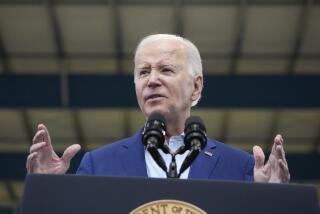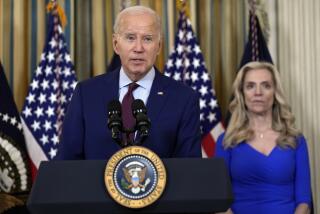Strategy to Aid Manufacturing Is Spelled Out
WASHINGTON — The Bush administration said on Friday that it wanted to create a presidential council on manufacturing and to preserve an outreach program previously targeted for elimination as part of an effort to aid the nation’s beleaguered factory owners.
The United States has lost 2.6 million factory jobs since President Bush took office, and administration officials and the National Assn. of Manufacturers characterized the initiative as a comprehensive strategy for addressing the overseas challenges that have contributed to the problem.
“The economy is on the right track. The manufacturing sector is growing. But we’ve got more work to do, and we know it,” said Commerce Secretary Don Evans, who outlined the plan in an address to business leaders in Cleveland.
But the blueprint was criticized by groups representing smaller manufacturers, who said it amounted to little more than a repackaging of previous initiatives and would still slash funding for the popular Manufacturing Extension Partnership program by two-thirds.
“This is an exercise in public relations and not in serious policymaking,” said Alan Tonelson of the U.S. Business and Industrial Council, which seeks more restrictive trade policies. “This strategy ignores the globalization-related aspects of the current manufacturing crisis.”
The “Manufacturing in America” report released by Evans represents the administration’s response to what some public and private sector officials have characterized as a crisis in the nation’s Factory Belt.
Although factory employment has been falling for two decades, the shrinkage accelerated sharply during the 2001 economic slump, and the losses have continued despite growing strength in other parts of the economy. The decline has become a key issue in 2004 political campaigns, particularly in hard-hit Midwestern states.
The issue has also divided the manufacturing community. Larger companies, many of which have operations overseas, cast much of the blame on taxes, government regulation, litigation and other domestic cost burdens. Smaller manufacturers tend to focus more on alleged trading abuses and currency manipulation by other countries, particularly China.
The administration’s initiative tries to address both sets of concerns. It calls on Congress to make the president’s tax cuts permanent, rein in litigation, restructure health care and reduce the regulatory burden. It also promises to help U.S. manufacturers become more competitive in increasingly global markets, and to crack down on what some consider unfair trading practices by other countries.
Bush already had promised to create a new assistant secretary position in the Commerce Department to coordinate the administration’s manufacturing policies. On Friday, Evans called for creation of a President’s Manufacturing Council composed of government officials and industry representatives to ensure that the concerns of factory owners received high-level attention in Washington.
“We are going to bring government together across the entire administration to focus on manufacturing issues,” Evans said.
But on one issue dear to smaller manufacturers, the administration’s strategy proved disappointing.
The White House wants to reduce funding for the Manufacturing Extension Partnership, an outreach program that helps small- and medium-size companies become more competitive. Last year, the program got $103 million; it is scheduled to drop to about $40 million this year and next.
Administration officials characterized the proposal as a change of heart, saying they had originally planned to phase out federal funding altogether. But advocates said the reduction would force widespread program cutbacks and layoffs.
“What they’re doing is cutting the program by two-thirds,” said Mike Wojcicki, president of the Modernization Forum, which represents 60 Manufacturing Extension Partnership extension centers and 400 satellite offices across the country. “I don’t think they’re fooling anyone.”
David Braunstein, president of the California Manufacturing Technology Center in Gardena, the nation’s largest partnership operation, said he had secured additional funding from the Defense Department that would mitigate the effect of the budget cuts in Southern California.
But other such providers will not fare as well, he said.
“They’re already laying people off,” Braunstein said. “It’s just not possible to maintain the same level of performance as before. My own estimate is we’re going to lose at least a third of the capacity to do the work.”
An administration official who briefed reporters acknowledged that the reduced funding would probably cause some partnership centers to shut down. But he said the administration hoped to make the program more efficient by channeling support to the most effective centers and consolidating its operations with other government programs.
More to Read
Inside the business of entertainment
The Wide Shot brings you news, analysis and insights on everything from streaming wars to production — and what it all means for the future.
You may occasionally receive promotional content from the Los Angeles Times.









